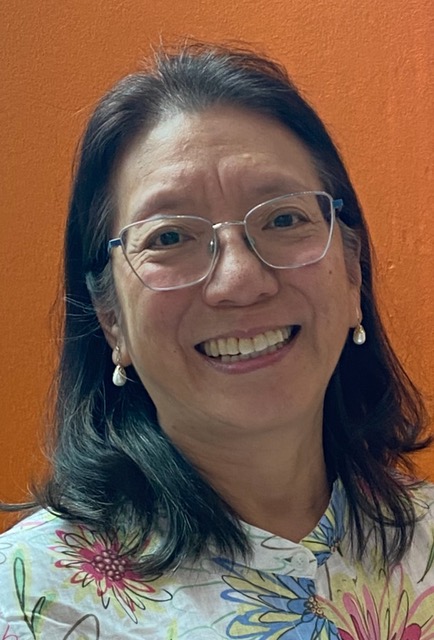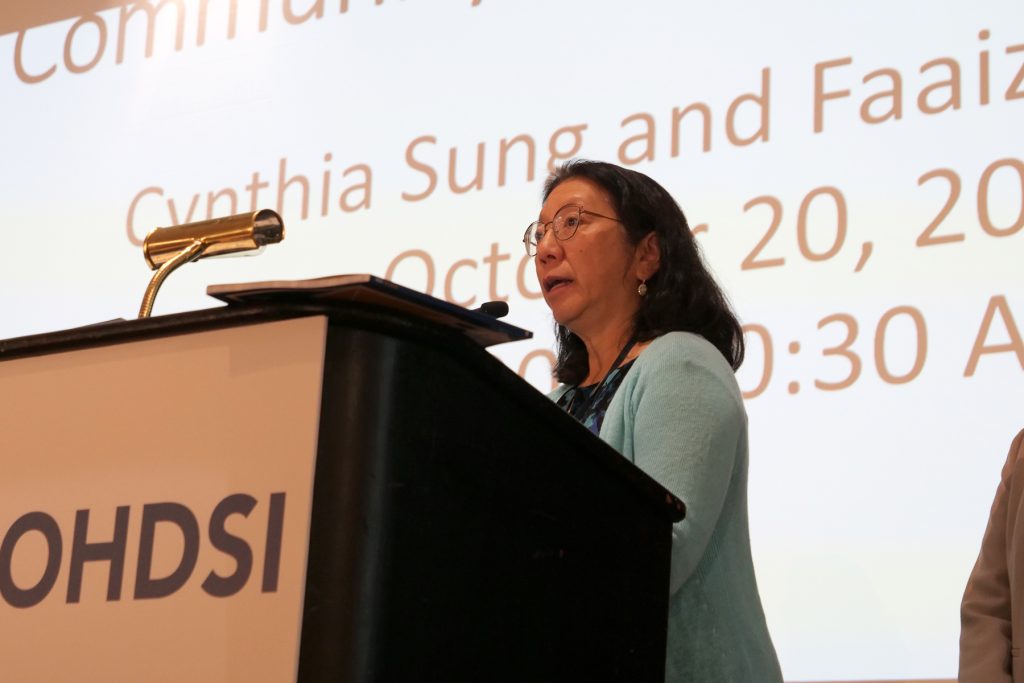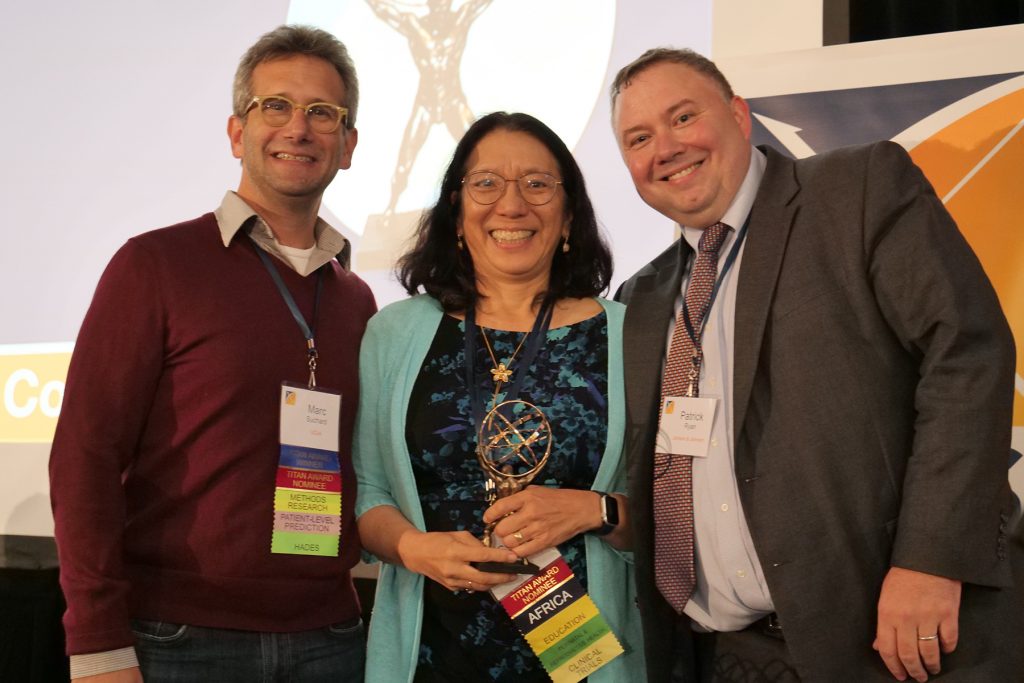- Who We Are
- Updates & News
- Standards
- Software Tools
- Network Studies
- Community Forums
- Education
- New To OHDSI?
- Community Calls
- Past Events
- Workgroups
- Tutorials
- 2025 ‘Our Journey’ Annual Report
- Current Events
- Support & Sponsorship
- 2025 Global Symposium
- 2025 APAC Symposium
- 2026 Global Symposium
- Github
- YouTube
- X/Twitter
- Newsletters
Collaborator Spotlight: Cynthia Sung
Dr. Cynthia Sung is an Adjunct Associate Professor for the Centre of Regulatory Excellence at Duke-National University of Singapore Medical School, teaching and developing curricula for the Graduate Certificate in Health Products Regulation. She consulted for Singapore’s Health Sciences Authority from 2006 to 2019, helping to build research programs in pharmacogenomics and data analytics. Cynthia has worked at the Gates Medical Research Institute, the US FDA, the US NIH, and at Human Genome Sciences.
Cynthia is an active member of the OHDSI Community, primarily as co-lead for the OHDSI Africa Chapter and also participating in working groups for Clinical Trials and Pregnancy and Reproductive Health. She was honored with the 2023 Titan Award for Community Collaboration. She is a Fellow of the American College of Clinical Pharmacology and holds a Ph.D. in Medical Engineering & Medical Physics from the Harvard-MIT Health Sciences Technology Program, a M.S. in Chemical Engineering from MIT, and a B.S. (summa cum laude) in Engineering and Applied Sciences from Yale University. Journal publications may be found here.
In the latest collaborator spotlight, Cynthia discusses a career journey that has taken her around the world, the need for FAIR data in less-represented populations, exciting developments within Africa, and more.

Can you discuss your background and career journey?
I was born and grew up in Queens, New York City. In my public junior high and high school, a number of teachers inspired an interest in math and chemistry, affecting my life’s trajectory. I went to college at Yale thinking I would major in math, but the abstract nature of the math curriculum pushed me toward the more practical discipline of chemical engineering. Between college and graduate school, I made a detour from science and engineering and taught English and American history for two years in Wuhan, a city that, at the time, few outside of China had heard of! Those years transformed my worldview in many ways. It was during that time that I came to appreciate that governance really matters, as it was apparent that government policies of the preceding decades had severely hampered economic and educational progress. My students were assigned where they would work after graduation, and young couples had to secure government permission to have a child (and only one). I am ever so grateful that I’ve had the freedom to make choices for my education, career and family.
My graduate studies at the Harvard-MIT Medical Engineering and Medical Physics Program allowed me to bridge the disciplines of chemical engineering and medicine, and prepared me for a research position in the Bioengineering and Physical Science Division at NIH. Subsequently, I worked in drug development at a biotechnology company conducting preclinical studies to support Phase 1 and 2 clinical trials of monoclonal antibodies and other protein drugs. Then I flipped to the other side of the table and joined the FDA/CDER to review submissions for INDs and NDAs. When my husband took a job in Singapore, I went as a “trailing spouse” with 3 young children in tow. Needing a flexible working situation where I could still be involved in scientific endeavors, I set up Rainbow Pharma Consulting. Among my clients were the Novartis Institute of Tropical Diseases, the Program for Emerging Infectious Diseases at Duke-NUS Medical School, and Singapore’s Health Sciences Authority (the local health product regulator) on drug development for tuberculosis, dengue, pharmacogenomics to identify subgroups at higher risk for adverse drug reactions, and piloting the use of electronic medical records for active surveillance of drug product safety.
After returning to the US in 2019, I joined the Bill and Melinda Gates Medical Research Institute as a research project manager for projects on maternal health, Covid-19, TB, malaria and vaccine adjuvants.
 What drew you to the OHDSI community, and what inspired you to become such an active collaborator?
What drew you to the OHDSI community, and what inspired you to become such an active collaborator?
In an era where safeguarding patient privacy is essential and oversight of data assets grows increasingly stringent, a federated model of collaboration through adoption of a common data model is the most feasible approach for handling and learning from big data across multiple organizations. I was especially drawn to OHDSI, not only for its commitment to transparency and use of open source software, but also for the energy and generosity of community members. I am inspired by the collective power that this volunteer-driven community has achieved.
You are particularly passionate about increasing the amount of FAIR data from less-represented populations, and you have been particularly focused on Africa as its chapter co-lead. How important — and challenging — is it to bring OHDSI into areas with less organized research ability.
Many diseases and conditions that afflict less-represented populations contribute to severe illnesses, loss of productivity and death. Increasing the amount of FAIR data from these countries holds the promise of advancing our understanding of these neglected diseases. Application of OHDSI tools has the potential to better characterize the diseases at those locales, identify sub-populations at greater risk, and suggest interventions for individual patients. This empowers clinicians to make more informed decisions that are contextually appropriate.
Introducing OHDSI into areas with less organized research ability is challenging, in part because of a history of “colonial science” as high income countries (HICs) often engaged low income country (LIC) teams merely as data collectors. The data were exported, analyzed, and published by HIC researchers, leaving LIC contributors with minimal credit or training in study design and analysis. This unfortunate legacy has made LIC researchers and governments highly protective of their data. The OHDSI model of data science, which places the power of decision making in the hands of the LICs, offers an attractive alternative to past practices. LICs control when and how their data are used and decide which collaborative studies to pursue. Spreading awareness of OHDSI’s equitable approach requires significant effort, though the growing recognition of OHDSI in Africa as a robust model for data harmonization, analytics and collaborative research is heartening.
Can you share some recent developments in Africa that have been exciting, and what are some hopes for 2025?
The Africa Population Health Research Center in Nairobi, Kenya secured funding from Wellcome Trust for an initiative called Data Science Without Borders. This program aims to build capacity for data harmonization to the OMOP CDM, promote open science in Kenya, Senegal and Cameroon, and pilot the use of no-code machine learning platforms for data analytics. Agnes Kiragga, a Ugandan who co-leads the OHDSI Africa Chapter, serves as the Principal Investigator on this grant. Another exciting event was the December 2024 kick off of the European EDCPT3-funded BRIDGE Training network. The proposal, developed by Marc Twagirumukiza, a Rwandan clinician based at the University of Ghent, Geert Byttebier, a biostatistician at Medaman, an EHDEN-certified SME, Marleen Temmerman, a Belgian obstetrician at Aga Khan University in Kenya and the University of Ghent and myself, has a goal to train 10 African Ph.D. students and 4 post-doctoral fellows in health informatics using OHDSI tools as the foundation for their research and prepare them to initiate and lead innovative, collaborative African-centered research. Students will do coursework at one of three institutions — located in Rwanda, South Africa or Benin — then conduct research under mentorship of faculty in Europe who are active in the OHDSI community. Another positive recent development is Chan-Zuckerberg funding for an OMOP CDM transform of health data in Kisumu County, Kenya, which has a population of 3.1 million.
In addition, the Malawi National Health Center and the Western Cape of South Africa Provincial Health Center have created OMOP CDM databases of health data. While the Africa Chapter has not settled on 2025 OKRs, a few popular ideas are to systematically catalogue vocabulary concepts that are unique to the African context and add them to the standard vocabulary, complete translations of The Book of OHDSI to French and Arabic in Github Markdown (which will make the updating process easier when the second edition is completed), do a deep dive on the data harmonization process, and strengthen partnerships with other organizations working in the data science/health informatics space in Africa. With growing utilization of OHDSI tools across Africa, we also hope to organize the first African Symposium in 2025.
You and Andy Kanter were instrumental in getting OMOP listed as a Content Global Good last year. Why was that important, and what does it say about OMOP?
Recognition of the OMOP CDM as a Content Global Good by Digital Square is a stamp of approval that gives data owners, government organizations and funding agencies confidence that a digital asset has been independently verified to meet standards of transparency, accessibility, interoperability, scalability, global utilization, mature documentation, and strong community engagement. Digital Square actively promotes the adoption of Global Goods in Low and Middle Income Countries (LMICs) to foster alignment and coordination in the digital sector. Now that the OMOP CDM has attained this selective status and is listed in the Global Goods Guidebook, it is poised to gain greater visibility in LMICs. Digital Square interfaces with funders and organizations driving digital health strategies, hence opportunities may arise to obtain funding to help health data owners in resource-limited countries transform their data to the OMOP CDM, expanding the coverage of data in the OHDSI network.
 You are a 2023 Titan Award winner for community collaboration. How special was that honor, and why is collaboration so critical to the success of this community?
You are a 2023 Titan Award winner for community collaboration. How special was that honor, and why is collaboration so critical to the success of this community?
It was very heartwarming to receive the award and know that my peers appreciate my efforts to foster collaboration. There is an African proverb “If you want to run fast, run alone. If you want to run far, run together.” I am amazed how far OHDSI has “run” in its 10 years of existence, it inspires me to do what I can to help members of this community run together.
What are some of your hobbies, and what is one interesting thing that most community members might not know about you?
I enjoy scuba diving, bike riding and yoga, and I recently resumed quilting. In a way, piecing together fabrics of different colors and shapes to create a single quilt is a metaphor for OHDSI. Most community members probably don’t know that in the past year, I have lived in four different places: Seattle, Claremont, Cape Cod, and Singapore. I do not recommend this nomadic existence, and I will be very glad to return to Falmouth, Cape Cod, Massachusetts in May, where I expect to stay for at least a few years.
